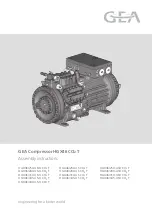
RXF ROTARY SCREW COMPRESSOR UNITS
OPERATION
070.410-IOM (JAN 12)
Page 21
THERMOSYPHON OIL COOLING
Thermosyphon oil cooling is an economical, effective method
for cooling oil on screw com pressor units. Thermo syphon
cooling utilizes liquid refrigerant at condenser pressure and
temperature which is partially vaporized at the condenser
temperature in a shell and tube or plate-type vessel, cooling
the oil. The vapor, at condensing pressure, is vented to the
condenser inlet and reliquified. This method is the most cost
effective of all currently applied cooling systems since no
compressor capacity loss or compressor power penalties are
incurred. The vapor from the cooler need only be con densed,
not compressed. Refrigerant flow to the cooler is automa-
tic, driven by the thermosyphon principle, and cooling flow
increases as the oil inlet tempera ture rises.
Figure 28
SYSTEM OPERATION:
Liquid refrigerant fills the cooler.
Warm or hot oil (above the liquid return temperature) flowing
through the cooler will cause some of the refrigerant to boil
and vaporize. The vapor rises in the return line.
The density of the refrigerant liquid/vapor mixture in the
return line is considerably less than the density of the liquid
in the supply line. This imbalance provides a dif ferential
pressure which sustains a flow condition to the oil cooler.
This relationship inv olves:
1. Liquid height above the cooler.
2. Oil heat of rejection.
3. Cooler size and piping pressure drops.
Current thermosyphon systems are using single-pass oil
coolers and flow rates based on 3:1 overfeed.
The liquid/vapor returned from the cooler is separated in
the receiver. The vapor is vented to the condenser inlet and
need only be reliquified since it is still at condenser pres sure
(see Figure 28).
INITIAL START-UP PROCEDURE
Having performed the checkpoints on the Prestart Checklist
(see FORMS in Table of Contents), the compressor unit is
ready for start-up. It is important that an adequate refrigerant
load be available to load test the unit at normal operating
conditions. The following points should be kept in mind dur-
ing initial start-up.
1. On start-up the unit should be operated at as high a load
possible for 3 hours. During the period, adjust liquid injection
oil cooling, if applicable. If unit has water-cooled oil cooling,
adjust water control valve to cooler (if applicable).
2. The compressor slide valve should be calibrated.
3. Pull and clean suction strainer after 24 hours operation. If
it is excessively dirty, repeat every 24 hours until system is
clean. Otherwise, follow the Maintenance Schedule. See the
RECOMMENDED MAINTENANCE PROGRAM section.
NORMAL START-UP PROCEDURE
1. Confirm system conditions permit starting the compressor.
2. Press the
[RUN]
key.
3. Allow the compressor to start up and stabilize. At start-
up, the slide stop (volumizer) and the slide valve (capacity
control) are in the
AUTO
mode.
4.
Observe the compressor unit for mechanical tightness of
the external piping, bolts and valves. Ensure that the ma-
chine is clean from oil and refrigerant leaks. If any of these
occur, shut down the compressor and correct the problem
as necessary using good safety precautions.
5. RETIGHTEN OIL SEPARATOR COVER BOLTS at con-
denser design pressure (while system is running) to 90
ft-lb for models 12 - 50.
RETIGHTEN MANWAY BOLTS at condenser design pressure
(while system is running) to 150 ft-lb for models 58 - 101
(11" x 15" manway); 180 ft-lb on 12" x 16" manway for
oversized separator on 85/101 models.
RESTARTING COMPRESSOR UNIT AFTER CONTROL
POWER INTERRUPTION (PLANT POWER FAILURE)
1. Check
ADJUSTABLE
setpoints.
2. Follow normal start-up procedure.
VFD SKIP FREQUENCIES
Criteria for Identifying Elevated Energy on VFD
Packages and Establishing “Skip” Frequencies
With the RXF running loaded at full speed, the entire package
must be physically checked for elevated energy, including
any corresponding extremities such as valves, liquid injec-
tion piping, brackets, tubing, oil cooler and oil piping. The
VFD speed is to be decreased by 100 rpm increments and
the entire package physically checked for elevated energy at
each stage until the minimum speed range is reached. As the
high energy hot spots are identified, they are to be checked
with a vibration meter and any readings that meet or exceed
one inch per second must have that frequency range skipped
in the microprocessor for the VFD, eliminating the ability of
the package to operate within that frequency range. Each
identified range needs to have the skip set to as narrow a
frequency band as possible, only making it wider until full
range is accommodated. Please also reference 070.902-IB
for acceptable package vibration readings.
Skip frequencies should be reviewed and verified annually.
















































